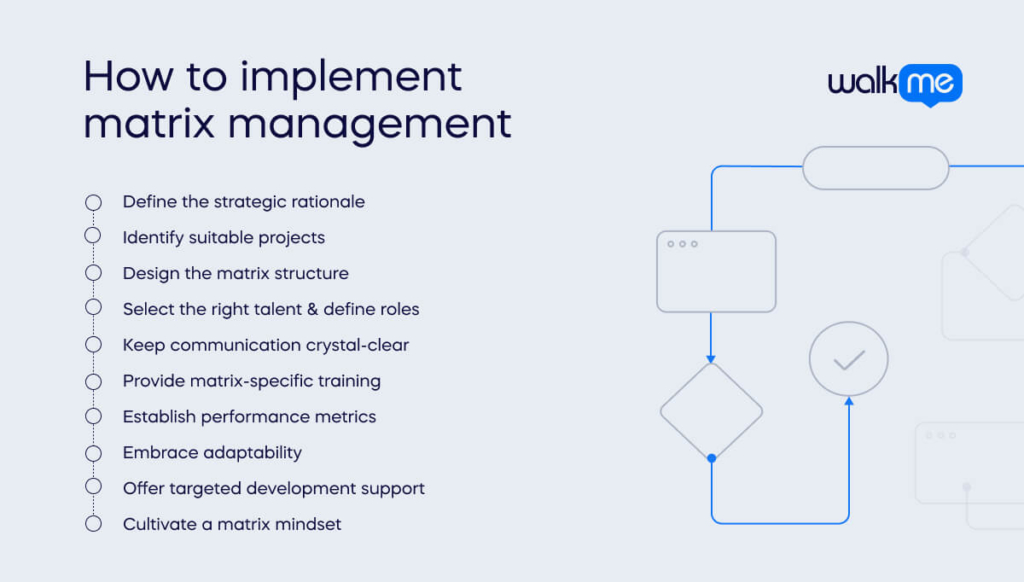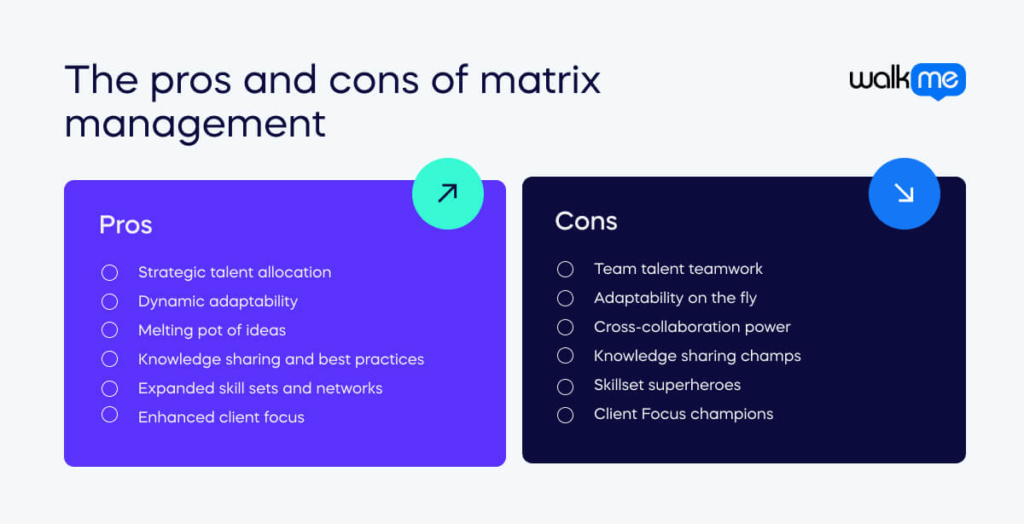Today’s businesses change quickly, so they need to be flexible and able to adapt.
This has led to something called matrix management. It’s a way to organize a company where people report to multiple bosses.
Matrix management lets companies best use their workers’ talents and resources across different projects. But it can also make it harder to communicate and make decisions.
In this article, we’ll unpack matrix management, examining what it is, how it functions, and its significance for businesses. We will also explore the advantages, disadvantages, and implementation steps.
What is matrix management?
Matrix management is an organizational structure where employees report to multiple managers. This system combines elements of traditional departments with project teams, ensuring cross-functional collaboration for project success.
In this system, employees report to a functional manager or project manager. A functional manager represents the expertise in their department. A project manager oversees specific projects with deadlines.
This lets companies use the specialized skills of different departments while keeping a goal-driven approach to projects.
Matrix management differs from traditional company structures, where employees have only one boss. Research from MIT Sloan Management Review shows how company organization is changing.
While companies talk about changing how they work, the old boss-on-top model is still the rule. It’s hard to change.
How does matrix management work?
Matrix management is an organizational structure where employees have two reporting lines. These are solid and dotted.
The solid line represents their primary reporting structure to a functional manager. This functional manager oversees their day-to-day work, performance evaluations, compensation, and career development within their specialization.
The dotted line establishes a secondary connection to a project or cross-functional manager. This manager guides specific projects but holds less direct authority than the solid line manager.
Decision-making in a matrix structure can vary. Sometimes, the solid line manager keeps ultimate authority, and the dotted line manager provides input. Other models emphasize collaboration, requiring both managers to reach a consensus on major decisions.
Why is matrix management important?
Today’s businesses must be agile, managing complexities like problem-solving, data-sharing, project collaboration, and resource allocation. Traditional siloed management structures often struggle to meet growing demands.
Matrix management offers a solution to address developing organizational needs, where innovation depends on cross-collaboration and quickly combining skills from across different teams.
When teams bring together people with different specialties, they unlock hidden potential within a company. These teams are where the best ideas are born because they combine everyone’s expertise.
Matrix management breaks down barriers between departments. This allows companies to use the right skills on every project. Companies tap into their full talent pool for better and more strategic solutions.
For example, a project needing marketing and technical expertise can easily draw from both areas within a matrix structure.
Matrix management works well with remote and hybrid teams. Companies can find the best people for the job, no matter where they work.
However, it also introduces challenges, such as coordinating work across time zones and navigating cultural differences in communication styles.
What are the different types of matrix systems?
As we know, matrix management structures enable better project execution, typically using a dual-reporting approach. However, the exchange of authority between these managers can vary. To understand these shifts, let’s explore the three main types of matrix systems:
Weak Matrix
In this model, the functional manager reigns supreme. They hold the primary decision-making power and control over resources, while the project manager plays a more supportive role, often focused on coordination and administrative tasks. This structure is ideal for situations where specialized expertise within functional departments trumps all.
Balanced matrix
This type strikes a middle ground. Both the project manager and functional manager share a balanced authority and responsibility. Project managers have more control over project budgets, timelines, and resource allocation within pre-defined parameters set by the functional managers. This collaborative approach helps create innovation and boost responsiveness while ensuring functional expertise remains readily available.
Strong Matrix
Here, the project manager takes center stage. They wield significant decision-making power and exercise greater control over project resources. Functional managers become more of a resource pool, providing specialized skills and expertise as the project manager needs. This structure is best suited for projects requiring high flexibility and rapid decision-making.
How to implement matrix management

Now that you understand a little more about matrix management, along with its benefits and challenges, let’s explore how you can implement it.
Remember, this represents a significant change in how your organization operates. With careful planning and execution, this structure can unlock new levels of teamwork and innovation – essential traits for future-ready firms.
1. Define the strategic rationale
Don’t implement a matrix structure without a clear purpose. Conduct a thorough analysis of the bottlenecks that are slowing your organization down.
Are different departments working in isolation, preventing valuable information from being shared? Does it take too long to get the right people working on the most important projects?
Is your organization unable to react quickly enough to changes in the market? Examine whether a matrix system – with its emphasis on collaboration, flexible resources, and adaptability – could offer a targeted solution to these specific problems.
2. Identify suitable projects
Choose the projects that would benefit most from a matrix approach. Target initiatives that require input and expertise from multiple departments to solve complex problems. Prioritize projects where the ability to shift resources or adjust timelines quickly is crucial for success in a changing environment. Consider pilot projects to test the matrix model in your specific organization before a full-scale rollout.
3. Design the matrix structure
Carefully consider the balance of power between project managers and functional managers that best aligns with your project needs and organizational culture.
In a weak matrix, project managers act as advisors with less direct control. A strong matrix empowers project managers with greater decision-making authority. Choose the structure (weak, balanced, or strong) that best supports effective project execution and aligns with your company’s approach to management.
4. Select the right talent & define roles
In a matrix environment, where priorities can shift rapidly, the ability to adapt quickly is essential.
Building a strong matrix team requires seeking out individuals who are naturally strong communicators, and are capable of building trust and rapport across different departments. Once the talent has been sourced, it’s time to define roles and responsibilities, along with processes for addressing any potential conflicts. This will set your team up for a smoother, more collaborative workflow.
5. Keep communication crystal-clear
In a matrix, clear and constant communication is critical. Set up regular meetings between all the teams working on a project, so everyone stays on the same page. Make sure there are easy ways to resolve disagreements quickly before they cause problems. Invest in tools that help people share files, updates, and ideas, even if they aren’t in the same office or department.
6. Provide matrix-specific training
General teamwork training isn’t enough for a matrix environment. Provide workshops or courses focused on the unique challenges that come up. Help employees feel comfortable working with multiple bosses, juggling different tasks at once, and resolving conflicts with people they don’t directly report to. The better equipped they are, the more smoothly projects will run!
7. Establish performance metrics
Think of your performance metrics as a compass for your matrix initiatives. Develop clear Key Performance Indicators (KPIs) that directly measure progress against the goals that led you to adopt the matrix in the first place. For example, if increased innovation is a core goal, track metrics that reflect changes in new product development timelines or the number of fruitful collaborations between previously siloed teams.
8. Embrace adaptability
A rigid approach will hinder progress in a matrix system. Be prepared to shift roles, processes, and even the structure itself when the needs of a project demand it. Staying in close communication with your teams is key – their insights will help you identify areas where adjustments will boost efficiency and effectiveness. This commitment to open-ended improvement is what will help you get the most out of the matrix model.
9. Offer targeted development support
Don’t expect employees to navigate the complexities of a matrix environment without the right support. Provide ongoing training specifically tailored to the challenges they’ll face. Focus on strengthening skills like negotiation, influencing others even when you lack direct authority, and finding constructive solutions to conflict. This type of focused development empowers individuals to thrive within the matrix and drive meaningful collaboration.
10. Cultivate a matrix mindset
Matrix management thrives when employees embrace a mindset shift, prioritizing collaboration, knowledge-sharing, and shared accountability across the organization. This shift goes beyond external structures – it’s about changing internal motivations and ways of working.
Seek out and celebrate employees who exemplify this mindset. Look for those who proactively break down silos, generously share their expertise, and consistently prioritize team goals. This recognition fosters a culture where the whole organization understands and values the psychological underpinnings of a thriving matrix environment.

What are the benefits of matrix management?
Addressing the complexities of modern business requires equally complex solutions. Matrix management takes a holistic approach to address this by sourcing talent from across the entire organization to hit new productivity levels.
With the right system in place, teams and departments will trigger benefits. Some benefits include:
Strategic talent allocation
Matrix management fosters a talent pool approach. By matching the right skills to the right project, organizations can ensure their top performers are dedicated to the most critical tasks. This targeted allocation of expertise leads to efficient resource utilization and maximizes the impact of their talent.
Dynamic adaptability
The agility of a matrix structure allows companies to reassign resources as priorities shift seamlessly. This adaptability ensures organizations remain responsive to changing market demands or internal needs. Teams can be restructured quickly to address new challenges, fostering a culture of continuous improvement.
Melting pot of ideas
Matrix teams bring together diverse perspectives from different departments. This exchange of knowledge and viewpoints sparks creativity and innovation. Enhancing collaboration across functions better enables teams to develop novel solutions and approaches that may have yet to emerge in a siloed environment.
Knowledge sharing and best practices
Matrix structures create a platform for knowledge sharing across the organization. As employees from different departments work together, they exchange best practices and gain exposure to various approaches.
Expanded skill sets and networks
Working on diverse projects within a matrix organization allows employees to develop new skills and expand their professional repertoire. This enhances their individual value and broadens their professional networks within the company, fostering stronger collaboration across departments.
Enhanced client focus
A core benefit of matrix management is its focus on assembling the best possible project teams. By strategically allocating talent, these teams can deliver superior results that meet or exceed client expectations. This focus on client success ultimately leads to greater satisfaction and stronger client relationships.
What are the challenges of matrix management?
We know when done right, matrix management can be a great system, but overcoming that learning curve isn’t always easy. Here are a few common challenges to keep in mind when trying to make it work:
Team talent teamwork
Matrix structures allow companies to create “dream teams” for projects by matching the right skills to the right job. This ensures top talent tackles the most critical tasks but requires clear communication about who does what.
Adaptability on the fly
Matrix management lets companies adjust when priorities shift. This keeps them responsive, but it can also lead to employees feeling like they’re being pulled in too many directions. Training and clear communication can help them manage their workload.
Cross-collaboration power
Matrix teams bring together different perspectives from various departments, sparking creativity. This can lead to innovative solutions, but it can also lead to disagreements between managers with different goals. Leaders need to establish a collaborative environment where everyone feels heard.
Knowledge sharing champs
Matrix structures create a platform for knowledge sharing across the organization. This can show the most effective methods, but it can also lead to an overwhelming amount of meetings and emails. Streamlined communication tools can keep everyone informed without wasting time.
Skillset superheroes
Working on diverse projects within a matrix organization allows employees to develop new skills and expand their professional network. This makes them more valuable, but can also make it difficult to measure their performance fairly. Collaborative performance reviews involving both functional and project managers can address this.
Client Focus champions
A core benefit of matrix management is its focus on assembling the best project teams. This can deliver superior client results, but some employees might resist change. Leaders must effectively communicate the benefits and help people adjust to the new way of working.
Overcoming the dilemma of matrix management
Matrix management presents a unique blend of challenges and opportunities. This organizational structure, characterized by dual reporting lines and interlacing responsibilities, often leads to role ambiguity, inter-managerial conflict, and communication barriers.
Despite these hurdles, the benefits, such as increased flexibility, improved inter-team collaboration, and more efficient resource allocation, justify the effort to master its complexities.
Effective strategies are crucial for success: clear definitions of roles and responsibilities, enhanced communication processes, robust training in conflict resolution, and the strategic use of technology are all imperative.
Maintaining an adaptive approach through continuous evaluation and willingness to adjust can leverage matrix management’s potential to the fullest. By embracing these practices, organizations can not only navigate but thrive within the dynamic landscape of matrix management.


